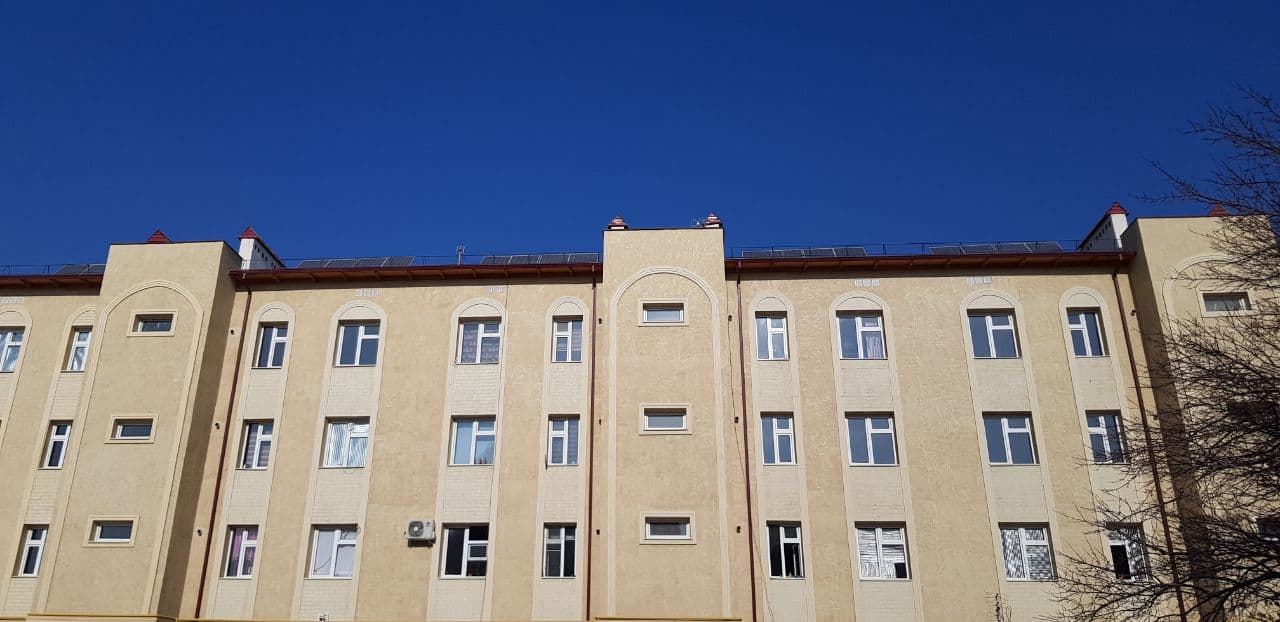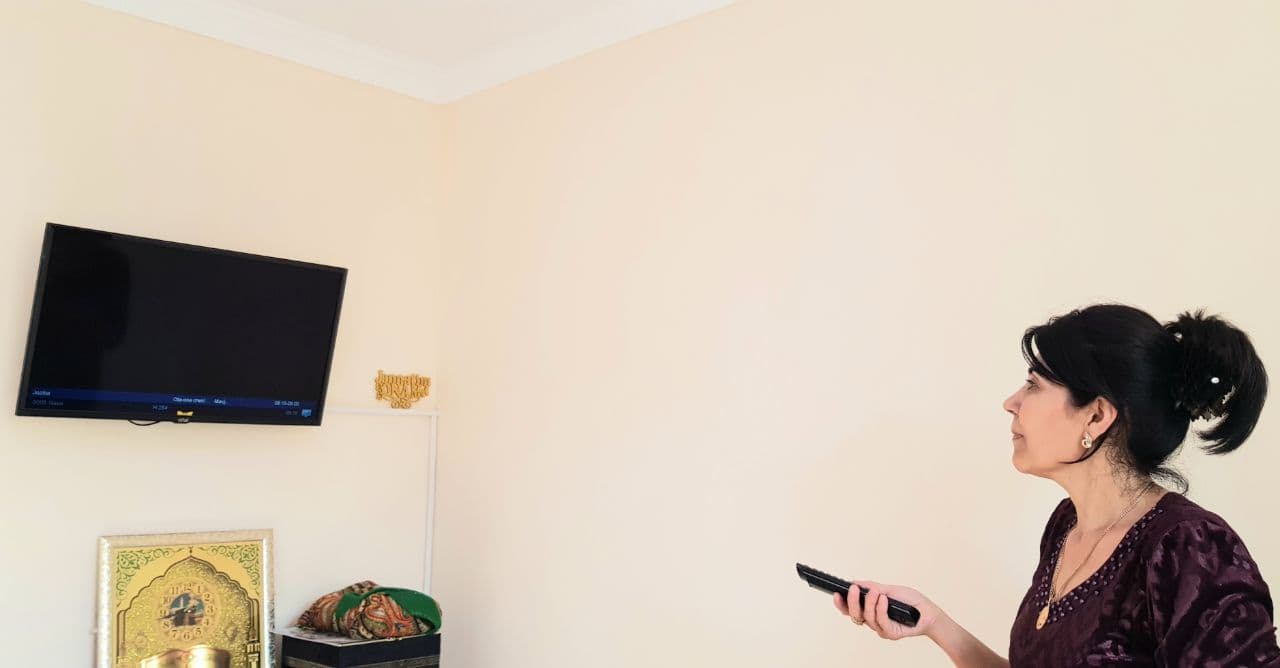Image: UNDP Uzbekistan (Four-storey EE house with solar panels in the Gulzor mahalla, Amudarya region, Republic of Karakalpakstan)
Global warming and the transition to sustainable lifestyle are among the are increasingly urgent priorities. The recent UN Climate Change Conference in Glasgow COP26 reminds us of the importance of immediate action by governments to reduce greenhouse gas emissions generated from human activity to avoid increase of the average global temperature over 1.5 degrees Celsius.
To comply with the objectives of the Paris Agreement on climate change, Uzbekistan is committed to reduce the specific greenhouse gas emissions per unit of GDP by 35% by 2030 from 2010 levels.
In addition to legislative reforms, many international organizations are supporting the Government of Uzbekistan in its transition to a green economy. Since 2017, the United Nations Development Programme (UNDP) in Uzbekistan and the Ministry of Construction of Uzbekistan, with grant support from the Global Environment Facility (GEF), have been implementing a six-year joint project “Market Transformation for Sustainable Rural Housing in Uzbekistan”. The main objective of the project is to provide the rural population of Uzbekistan with improved and affordable environmental-friendly living conditions through the application of energy-efficient design and renewable energy technology.
Energy efficiency (EE) and renewable energy in housing offer several major benefits. They conserve natural resources. They reduce emissions of greenhouse gases, in addition to reducing local pollution impacts. They also reduce electricity and gas bills, thus leaving more net income available for residents and increasing overall affordability of household operations.
In recognition of these benefits, the President of the Republic of Uzbekistan has issued important recent decrees on energy efficiency and renewable energy. Presidential Decree PD-4422 of 22 August 2019 promotes the widespread introduction of energy-saving technologies and renewable energy sources. According to the Presidential Decree PD-5577 of 14 November 2018, starting from 1 January 2020, all housing construction facilities should be equipped with energy-efficient and energy-saving equipment at design and construction phases. The project is supporting these mandates by introducing new energy-efficient building designs, revising building codes for energy performance, and supporting the construction of affordable rural housing with energy efficient and renewable energy technology. The project’s main focus, in accordance with the State Programme on rural housing, has been energy-efficient and low-carbon (LC) multi-story apartment buildings. EE and LC multi-story houses supported by the project have essentially no external differences compared to standard multi-story houses. This EE and LC housing has everything necessary for comfortable living - hot water, lighting, heating, ventilation system and so on, and indeed even surpasses standard housing in terms of overall affordability, comfort, and sustainability.
The basic design principle of these houses is to use various thermal protection technologies such as basalt fibre mineral wool insulation to reduce heat losses and wasteful heat energy use as much as possible. A well-insulated building envelope also keeps buildings cooler in Uzbekistan’s hot summers.
The project has also supported the use of solar energy technology to displace consumption of fossil fuels. The project supported installation of 600 W photovoltaic systems (solar panels and accompanying hardware) on the roofs of 22 four-story 24-apartment buildings, built in Tashkent, Namangan, Bukhara and Kashkadarya provinces and the Republic of Karakalpakstan in 2020. These units provide the apartments with electricity for basic needs: lighting, charging devices, TV and refrigerators.

Four-story EE house with solar panels, Gijduvan district, Bukhara region
Feruza Shokirova, a resident of a house in Gijduvan district of Bukhara region, tells about her experience of living in EE apartment: “Our flats are comfortable and cost-effective. We have saved a lot on our gas and electricity bills this year. Energy from solar panels is mainly used for house lighting, watching TV and charging personal devices.”
 A resident of a four-story EE house. Gijduvan district, Bukhara region
A resident of a four-story EE house. Gijduvan district, Bukhara region
Madina Nurchaeva, a neighbour of F. Shokirova, noted that there were no electricity outage problems in this house. “Another advantage is that the temperature inside apartment is easily regulated. There is no overheating in winter, and comfortable temperature is kept in summer,” notes Madina.
 A resident of a four-story EE house. Peshku district, Bukhara region
A resident of a four-story EE house. Peshku district, Bukhara region
In the Navbahor mahalla in the Peshku district of the Bukhara region, flats in four-story EE and LC multiapartment houses are provided to low-income families and people with disabilities on subsidized loans for 20 years.
“My daughter Rano and I were happy to buy an apartment in such a house on a preferential term,” says Rakhima Salimova, a resident of energy-efficient and low-carbon apartment building #22 in Navbakhor. “We use electricity from solar panels for our daily needs. In addition, domestic household appliances run on electricity from these batteries without any problems. This is a big saving for our family budget.”
Solar panels on the roof of a four-storey EE house in the Gulzar mahalla, Amudarya region, Republic of Karakalpakstan
According to industry representatives, the implementation of such projects in the country, especially in rural areas, is important for the stability of the economy, society and the environment, as well as for ensuring the well-being of the population.
“Installing solar panels is an excellent solution to improve living conditions,” says Zafarjon Atamuratov, one of the owners of a flat in the EE and LC house in the Gulzar mahalla of the Amu Darya region in the Republic of Karakalpakstan. “We do not have problems with power outages. All residents are happy about it.”
In 2021, 30,000 energy-efficient apartments have been built in Uzbekistan. At the moment, a state programme for 2022 is being developed for the construction of another 60,000 EE and LC apartments in rural areas of Uzbekistan.

 Locations
Locations



